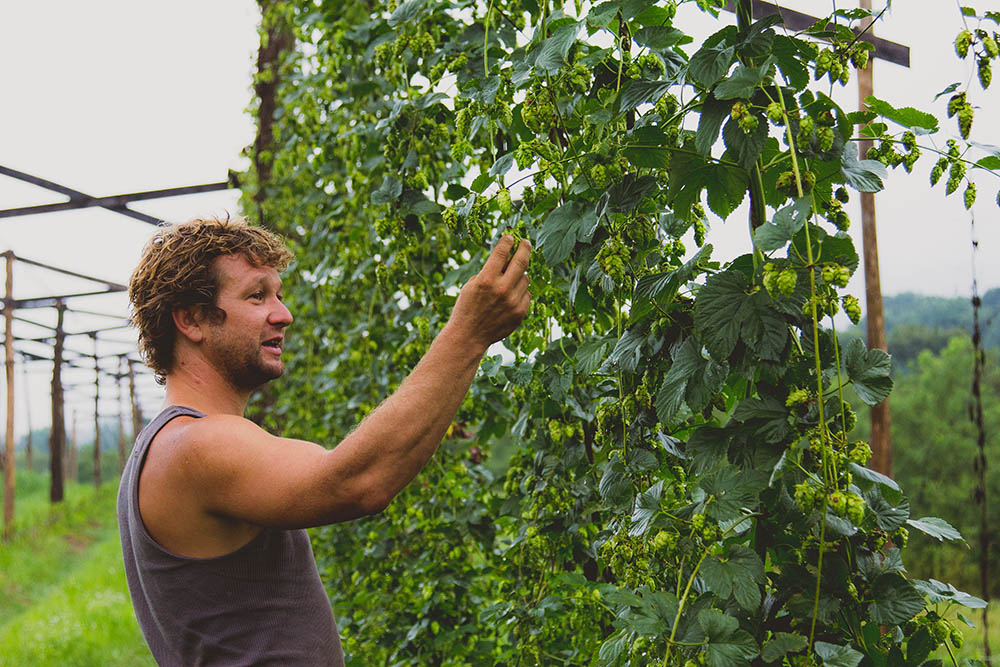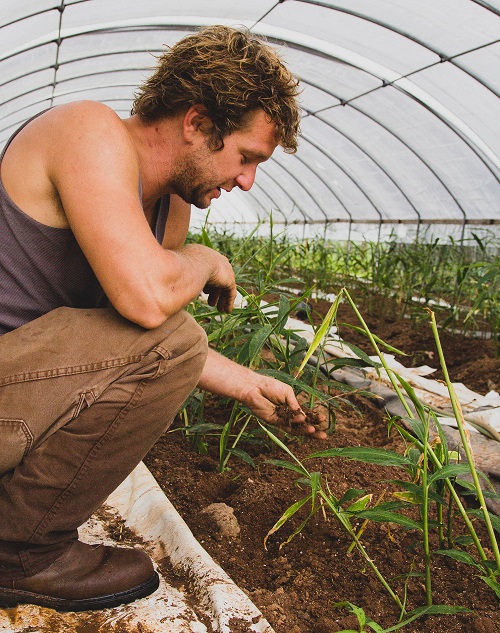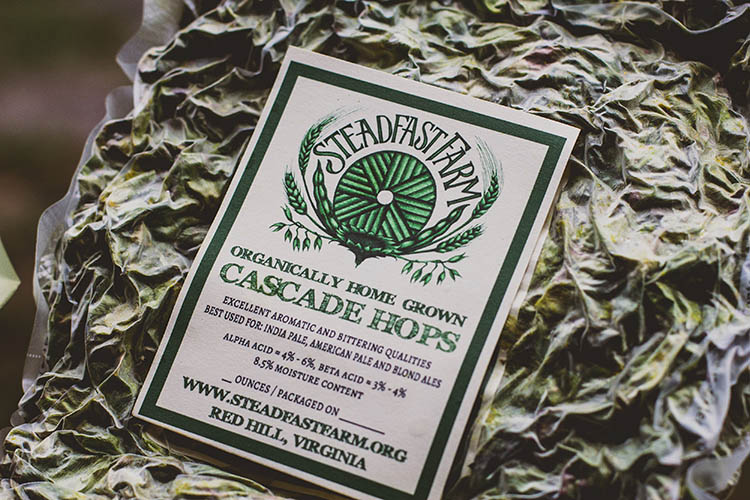With additional acreage, added opportunity
For Brian Walden, his path to farming started with 250 acres of land.
He grew up on the property his family bought in Albemarle County in the 1980s, but his parents never farmed its rolling acreage themselves. His dad worked in the city and leased the land out to farmers who mowed it or kept cattle on it at various times, “but never productive farming,” Walden said.

Walden went on to study education and agriculture at the University of Vermont, interested in the landscape on which he’d grown up but not yet committed to it.
“I went to college and, as time went on and I learned about what I wanted to do, the farm was that palette that I could access,” Walden said.
Walden and his wife Mihr, now in their early 30s with two children, moved back to his family’s land almost a decade ago and “started learning how to manage the land we have already.”
Since then, they’ve built a house and their Steadfast Farm has taken on twice the amount of land through a handful of leases, mostly to manage his neighbors’ fields. Walden sees the landscape as a blank slate and considers anew each year what it might be best suited to grow or graze.
Walden started out with a small herd of cattle and taught himself how to make hay. Though he wanted to sell to local markets, he preferred the efficiency of livestock and rotational systems to the painstaking work of raising vegetables in rows. He also had a lot of land, much of it hilly, and wanted to make the most of it.
Steadfast Farm has taken on twice the amount of land through a handful of leases, mostly to manage his neighbors’ fields. Walden sees the landscape as a blank slate and considers anew each year what it might be best suited to grow or graze.
“I started to think more about the ability of me to produce more from an acre of land than what was being produced,” he said. “And grain was an obvious option.”
Walden saw in crops like wheat and barley the opportunity to bring the nutrient cycle of his cows and the land full-circle. But, in order to process the commodity-scale products, even for a local market, he had to get some oil as well as dirt under his fingernails.
Equipment
Because he already had access to land, and leases additional acreage for virtually nothing (the lease to make hay on his neighbor’s 250 acres is based mostly on a handshake), Walden funneled his investments toward second-hand equipment. One of his first purchases was a small, 1950s John Deere combine that was big enough to manage a few acres.
He recognized that the consolidation of larger farms in this country was turning plenty of high-dollar machines into unwanted scrap metal, ready to be snatched up for discounted prices.
He said equipment and access to land are the main reasons more farmers don’t grow grains for local markets, despite a growing interest in locally produced flour for bakers and barley for brewers.
Walden’s barns are now brimming with combines, tractors, a small grain mill and even a retro seed cleaner that he’s picked up over the years. If he doesn’t know where to process something he’s grown, he considers buying the equipment to do it himself. If he doesn’t know how to use it — or how to fix it when it’s broken — he learns.
“I made the choice to start using this machinery, and now I’m deep into it. I take care of 50 separate wheels; I’ve got 12 drivelines — the amazing things I’ve got to handle just to make the farm work,” Walden said a couple years ago, after his first five years of growing grains and accumulating equipment.
He said equipment and access to land are the main reasons more farmers don’t grow grains for local markets, despite a growing interest in locally produced flour for bakers and barley for brewers.
The markets

This summer, Walden harvested 20 acres of hard white winter wheat that he’ll store at 45 degrees “almost indefinitely” in a refrigerated tractor-trailer he acquired.
He’ll sell some of it to the historic Woodson’s Mill that was recently revived in Nelson County to process flour and grits for local markets. Some of that flour, though not necessarily labeled as Steadfast Farm’s, will end up at Dr. Ho’s Humble Pie, a pizza café that’s a short drive from the farm.
But the majority of it will go to North Carolina, where a revived system supporting local grains — from grower to miller to baker — is making better headway than it has so far in Virginia.
Walden does mill a small batch of the grains himself, but he no longer exhausts himself trying to sell grains through a local CSA or at the Charlottesville Farmers Market, where most customers barely recognized the wheat berry kernels he tried to sell once, let alone knew what to do with them.
Walden’s farm business has entailed plenty of trial, error and a few successes. He seems to thrive on experimentation and it can be difficult to keep tabs on what he has in the works at any given moment.
During a visit in 2012, Walden was fixated on establishing local markets for his grains, the flour from which we could sample in the pizza dough at Dr. Ho’s. He was making most of his income selling the beef from his cattle through a CSA and at the farmers market.
But, this year, Walden put his cattle on a trailer and sold them in Staunton, because they were garnering such a high price on the conventional cow-calf market that he couldn’t “justify hustling it around” to local buyers.
Walden is working on setting up better rotational systems at the farm that could allow him to grow the herd beyond the 40 head of cattle he maintains now. This spring, he received 100-percent funding from the state to build fences and watering troughs that keep his cattle out of the streams and give him the ability to move them more strategically through the pastures.
He sees opportunity in selling the cattle locally once he can generate more volume with better systems.
But, for now, he’s thinking small.
Specialty crops
As primed as Walden’s land is to support cattle and grains, he’s always had a soft spot for a brand of farming that makes a lot of money with a little bit of product. On a bit of flatlands near the cabin in which he and his wife first lived is a plot of land that serves as a sort of research station for the farm.
As rain begins to roll off the mountains and onto the farm one July afternoon, Walden ducks into a 3,000-square-foot greenhouse that’s growing neat rows of what looks like bamboo shoots. It’s ginger root, and lots of it.

Next to the greenhouse is a row of vines that are just beginning to crawl up the posts and wires that will support their fruit. The kiwi berries — picture green kiwis the size of a large grape, without the fuzz — won’t be ready to harvest for five years. But Walden thinks the specialty crop that can earn a high price will be pre-sold to buyers before it’s even picked.
“They’re a super food, most vitamin C per unit of weight you can get anywhere. And nobody’s doing them,” he said.
Beyond the burgeoning kiwi berries are what look like telephone poles bearing the crop that, for now, is generating the most excitement and marketing energy from Walden: hops.
He would harvest the last of this crop that day, once the rain stopped. He’d then dry the hops and vacuum pack them with a label his wife designed for sale to local beer brewers and herbalists. Walden had been promoting the new product at farmers markets for weeks, and it was generating plenty of interest among local brewers.
After growing a third of an acre of hops this year, Walden said he only has enough product to sell to the highest bidder.
“Home brewers will pay top dollar,” he said. “I only have so many dollars here, so I’ll sell to those.”
This story is part of “Finding a Place to Grow“, a publication produced by The Piedmont Environmental Council. The stories were written by Whitney Pipkin, a freelance journalist from Alexandria, VA who covers food, farms, and the environment. Her work appears in the Washington Post, Virginia Living and the Chesapeake Bay Journal, among others, and she writes at thinkabouteat.com. Photos were taken by Jami McDowell.
The publication was made possible by a grant from The Beirne Carter Foundation.
